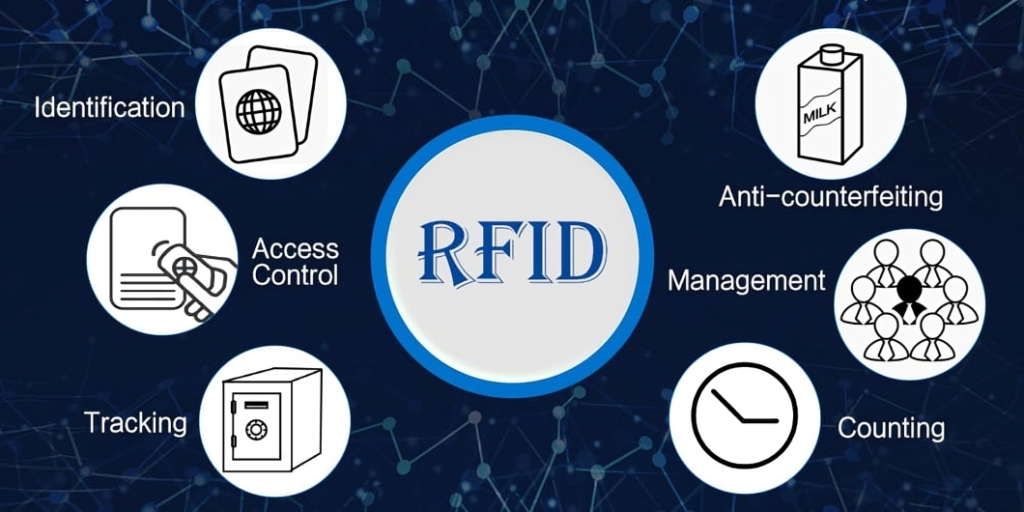In today’s competitive jewelry market, maintaining accurate inventory control while ensuring security has become more critical than ever. Traditional methods of tracking valuable jewelry pieces through manual processes are not only time-consuming but also prone to human error and security vulnerabilities. This is where an RFID Jewelry Tracking System emerges as a game-changing solution, offering unparalleled accuracy, security, and efficiency in jewelry inventory management.
Managing inventory efficiently is a constant challenge in the fast-paced, high-value world of jewelry retail. From preventing theft to ensuring seamless customer experiences, jewelers need robust solutions to stay competitive. Enter RFID Jewelry Tracking Systems, a game-changing technology transforming how jewelers track, manage, and secure their inventory.
Understanding RFID Jewelry Tracking System Technology
Radio Frequency Identification (RFID) technology forms the backbone of modern jewelry inventory management systems. An RFID Jewelry Tracking System utilizes electromagnetic fields to automatically identify and track tags attached to jewelry items. These systems consist of three main components: RFID tags, RFID readers, and a central management software platform.
Modern RFID Jewelry Tracking Systems can operate on various frequencies, with Ultra High Frequency (UHF) being particularly popular for jewelry applications due to its longer read range and faster data transfer rates. This technology enables jewelers to conduct comprehensive inventory counts in minutes rather than hours, significantly improving operational efficiency.
Key Benefits of Implementing an RFID Jewelry Tracking System
Enhanced Security and Loss Prevention
Security remains a paramount concern for jewelry retailers and manufacturers. An RFID Jewelry Tracking System provides multiple layers of security protection. The system can detect unauthorized movement of items, trigger alerts when jewelry pieces leave designated areas, and maintain detailed audit trails of all inventory movements. This level of monitoring significantly reduces the risk of theft and helps identify potential security breaches before they escalate.
The real-time tracking capabilities of an RFID Jewelry Tracking System also enable immediate detection of missing items. If a piece of jewelry is misplaced or stolen, the system can quickly identify its last known location and movement history, facilitating faster recovery efforts and reducing losses.
Improved Inventory Accuracy and Management
Manual inventory processes in jewelry stores are notoriously time-consuming and error-prone. An RFID Jewelry Tracking System eliminates these issues by providing automated, real-time inventory updates. Staff can conduct complete inventory counts using handheld RFID readers in a fraction of the time required for manual counting, while achieving near-perfect accuracy rates.
The system maintains detailed records of each jewelry piece, including its location, movement history, and current status. This information enables better decision-making regarding stock levels, reordering, and merchandise placement. Jewelers can also track which items are most popular, helping optimize their inventory mix and reduce slow-moving stock.
Streamlined Operations and Customer Service
An efficient RFID Jewelry Tracking System transforms daily operations within jewelry stores. Staff can quickly locate specific items for customers, reducing wait times and improving the overall shopping experience. The system can also track which pieces customers have viewed or tried on, enabling personalized follow-up and targeted marketing efforts.
For jewelry manufacturers and wholesalers, RFID systems provide complete visibility throughout the supply chain. From production to retail, every movement of jewelry items is tracked and recorded, enabling better coordination between different stakeholders and reducing the risk of items being lost or misplaced during transit.
Advanced Features of Modern RFID Jewelry Tracking Systems
Integration with Point-of-Sale Systems
Contemporary RFID Jewelry Tracking Systems seamlessly integrate with existing point-of-sale (POS) systems, creating a unified platform for sales and inventory management. When a jewelry piece is sold, the system automatically updates inventory levels, removes the item from available stock, and generates detailed sales reports. This integration eliminates the need for manual data entry and reduces the risk of discrepancies between sales and inventory records.
Mobile and Cloud-Based Access
Modern RFID Jewelry Tracking Systems offer mobile applications and cloud-based access, allowing jewelry business owners and managers to monitor their inventory from anywhere. Real-time dashboards provide insights into inventory levels, sales performance, and security alerts, enabling proactive management decisions even when not physically present in the store.
Analytics and Reporting Capabilities
Advanced RFID Jewelry Tracking Systems include powerful analytics and reporting features that provide valuable business insights. These systems can generate reports on inventory turnover rates, popular items, seasonal trends, and customer preferences. Such data-driven insights help jewelers make informed decisions about purchasing, pricing, and marketing strategies.
Implementation Considerations for RFID Jewelry Tracking Systems
Choosing the Right RFID Technology
Selecting the appropriate RFID technology for a jewelry tracking system requires careful consideration of various factors. The size and material of jewelry items, the desired read range, and the operating environment all influence the choice of RFID tags and readers. An effective RFID Jewelry Tracking System must balance performance requirements with practical considerations such as tag visibility and customer acceptance.
Passive RFID tags are typically preferred for jewelry applications due to their small size and lack of battery requirements. However, the metallic composition of many jewelry items can interfere with RFID signals, requiring specialized tags and careful system design to ensure reliable performance.
Staff Training and Change Management
Successful implementation of an RFID Jewelry Tracking System requires comprehensive staff training and effective change management. Employees must understand how to use RFID readers, interpret system alerts, and follow new procedures for inventory handling. Proper training ensures that staff can maximize the benefits of the system while maintaining security and accuracy standards.
System Maintenance and Support
Like any technology solution, an RFID Jewelry Tracking System requires ongoing maintenance and support. Regular system updates, tag replacement, and hardware maintenance are essential for optimal performance. Choosing a system provider that offers comprehensive support services and has experience in the jewelry industry is crucial for long-term success.
ROI and Cost-Benefit Analysis of RFID Jewelry Tracking Systems
Quantifying the Benefits
The return on investment (ROI) for an RFID Jewelry Tracking System can be substantial when properly implemented. Cost savings from reduced labor for inventory counting, decreased losses from theft and misplacement, and improved inventory accuracy all contribute to the system’s financial benefits. Many jewelry businesses report ROI periods of 12-24 months, with ongoing benefits continuing well beyond the initial payback period.
Improved customer service and faster inventory processes can also lead to increased sales and customer satisfaction. The ability to quickly locate items and provide detailed product information enhances the customer experience and can result in higher conversion rates and repeat business.
Long-term Strategic Advantages
Beyond immediate cost savings, an RFID Jewelry Tracking System provides strategic advantages that position jewelry businesses for future growth. The detailed data collected by these systems enables better business intelligence and strategic planning. As the jewelry industry continues to evolve, businesses with robust tracking and analytics capabilities will be better positioned to adapt to changing market conditions and customer expectations.
Future Trends in RFID Jewelry Tracking Systems
Integration with IoT and Smart Store Technologies
The future of RFID Jewelry Tracking Systems lies in their integration with broader Internet of Things (IoT) ecosystems and smart store technologies. Advanced systems will incorporate environmental monitoring, automated security responses, and predictive analytics to create truly intelligent jewelry management platforms.
Blockchain Integration for Authenticity Verification
Emerging trends include the integration of RFID systems with blockchain technology to create immutable records of jewelry provenance and authenticity. This combination of technologies addresses growing consumer concerns about conflict minerals and counterfeit jewelry while providing additional value to customers and businesses.
Artificial Intelligence and Machine Learning
Future RFID Jewelry Tracking Systems will leverage artificial intelligence and machine learning to provide predictive insights, automated reordering suggestions, and advanced fraud detection. These capabilities will further enhance the value proposition of RFID technology in jewelry applications.
How RFID Jewelry Tracking Systems Work
RFID (Radio-Frequency Identification) technology uses tiny tags embedded with microchips to store and transmit data wirelessly. Here’s how it revolutionizes jewelry management:
- Tagging Items: Each jewelry piece is equipped with a discreet, tamper-proof RFID tag (e.g., embedded in a pendant’s clasp or a ring’s inner band).
- RFID Readers: Wall-mounted, handheld, or countertop scanners detect tagged items within seconds, even through glass cases or packaging.
- Real-Time Data Sync: Inventory counts, sales, and restocking alerts update automatically in cloud-based software, accessible via tablets or POS systems.
Unlike barcodes, RFID tags don’t require line-of-sight scanning. A single scan can detect hundreds of items simultaneously, reducing labor by 70% and enabling instant stock audits.
Related Post: Redefining RFID Tagging in Jewelry with JewelSteps Software
Key Features to Look for in RFID Jewelry Tracking Systems
When choosing a system, prioritize these features:
- High-Frequency (HF) RFID Tags: Ideal for small items like earrings, offering precise detection within 1-3 meters.
- Cloud-Based Analytics: Track sales trends, peak demand periods, and customer preferences.
- Customizable Alerts: Receive notifications for low stock, unauthorized movements, or VIP client requests.
- Durability: Tags resistant to water, heat, and chemicals ensure longevity, even for frequently cleaned items.
- POS Integration: Sync RFID data with sales systems for seamless checkout and inventory updates.
Implementing RFID Jewelry Tracking Systems: A Step-by-Step Guide
- Audit Current Inventory: Start by tagging high-value items (e.g., diamond collections) and categorize them by type, price, or supplier.
- Choose Hardware: Opt for jewelry-specific RFID readers (e.g., Magic RFID’s compact handheld scanners) and tags designed for delicate items.
- Train Your Team: Conduct workshops to teach staff how to scan items, interpret alerts, and troubleshoot.
- Test and Optimize: Run a 30-day pilot to identify gaps (e.g., blind spots in reader coverage) and refine workflows.
- Monitor and Grow: Use data analytics to forecast demand, optimize stock levels, and expand RFID use to packaging or repairs.
Conclusion:
The implementation of an RFID Jewelry Tracking System represents a significant step forward in jewelry inventory management and security. These systems offer unprecedented visibility into inventory movements, enhanced security features, and operational efficiencies that can transform jewelry businesses of all sizes. While the initial investment and implementation effort are substantial, the long-term benefits in terms of reduced losses, improved accuracy, and enhanced customer service make RFID technology an essential tool for modern jewelry retailers and manufacturers.

